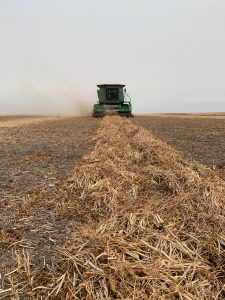 September 16, 2020
September 16, 2020
- Crop Update
- Soybean Harvest Tips
- Reducing Soybean Harvest Losses
- Residue Management Following Soybean Harvest
- Enhancing Soybean Storage Starts with Harvest Moisture
- On-Farm Network Update
- Harvest Sample Program
Listen to The Bean Report:
Crop Update
- Soybeans range from R7 (physiological maturity; at least one brown pod on the main stem) to R8 (full maturity) across the province. Harvest has begun for the earliest-seeded and earliest-maturing soybean varieties. Early yield reports are above 37 bu/ac. Cooler weather this week will slow down maturity. Last week’s frost affected soybeans at the R6.5-R7 stages.
- Dry bean harvest is now fully underway. Dry beans in western MB at R8 have been affected by the frost.
- Field pea harvest is nearly complete.
- Faba bean harvest is underway.
Soybean Harvest Tips
- Soybeans are ready for harvest 5-10 days after R8 has been reached. At R8, 95% of pods are brown, all leaves have dropped and seeds rattle within pods.
- Direct harvest soybeans at 13-14% seed moisture using a flex header.
- Keep harvest speed below 5 mph to minimize header loss. Measure losses regularly during harvest to optimize your combine settings.
- If soybean seed moisture is <11%, harvest when humidity is high to reduce shatter loss and mechanical damage.
Reducing Soybean Harvest Losses
A research update from the Prairie Agricultural Machinery Institute
Since over 80% of harvest losses occur at the header, it is our main focus for protecting yield at harvest time.
Tips for reducing header losses:
- Type of header – A draper header, when properly adjusted (i.e., to the bean setting), can reduce yield loss by 0.5-1 bu/ac compared to an auger header.
- Angle setting of the header – Spend the time adjusting the header angle settings between crops to minimize losses, regardless of the header type. Getting the knife positioned between the ground and lower tip of the bottom pod is key.
- Use of an air system – Losses can be reduced by 0.5-1 bu/ac, on average, when using an air system on either a draper or auger header. At a price of $10/bu, this can provide a savings of $5-10/ac. To determine if an air system is worth the investment, consider that the payback area for an air system with an average capital cost of $16,500 would be 1,650-3,300 acres. This indicates that using an air system can provide substantial benefit in reducing losses.
- Ground speed – The effect of ground speed needs to be weighed against the urgency of harvest. Combine speeds of 3-4 mph reduce losses compared to higher speeds of 5-7 mph (average difference of 0.5 bu/ac).
Residue Management Following Soybean Harvest
 Soybean residue left on the soil surface after harvest can break down without incorporation. Research conducted in Manitoba by Dr. Yvonne Lawley (U of M) found that ground cover by soybean residue broke down naturally by 31 to 57 % from fall to spring.
Soybean residue left on the soil surface after harvest can break down without incorporation. Research conducted in Manitoba by Dr. Yvonne Lawley (U of M) found that ground cover by soybean residue broke down naturally by 31 to 57 % from fall to spring.
This research also found that discing, cultivating and vertical tilling, compared to no-till, had no effect on soil temperature and moisture at a 2-inch depth during emergence the following spring. There were no yield differences among these soybean residue management practices in the following corn and wheat crops.
Soybean Storage Tips
- The market moisture for soybeans is 13%, which is fine for storage under cool conditions. If storing through winter and warmer weather, aim for 11% moisture to limit mould growth and deterioration. The storage life roughly doubles for each percentage point of reduction in moisture content.
- Equalize soybean moisture content. Soybean moisture variation may lead to storage and marketing losses. Operating an aeration fan will help move moisture from wet to drier beans.
- Cool soybeans throughout fall and winter to maintain quality. Aerate to keep stored seed within 5-10 degrees of the average outdoor temperature during the fall. Store soybeans near 0°C during the winter.
- Once soybeans are cooled, cover fan and duct openings to prevent snow or moisture from blowing into the bins.
- Monitor soybeans at least once every two weeks during the fall. Outside temperature changes can result in temperature and moisture changes inside the bin.
Find information for pulse crops in the Saskatchewan Pulse Growers Post-Harvest Storage of Pulses fact sheet.
On-Farm Network Update
On-Farm Network dry bean trial harvests are continuing, with two more in the books. Both were dry bean nitrogen trials, comparing low, medium and high nitrogen fertility plans. One trial compared 35, 75 and 105 lbs N/ac, spring-applied into pinto beans (left). The other trial compared 40, 70 and 100 lbs N/ac, spring-applied in black beans (right). Both trials showed an unexpected trend in yield results… but are they significant? Stay tuned for the final reports later this year!
As harvest continues and fall field work picks up, trial opportunities abound! Wondering what tillage strategy might be best for your pulse or soybean production? Curious about the best rate of fall applied P or K for soybean production? Let us know and we can talk about trial options! Email megan@manitobapulse.ca or text/call Megan at 204-751-0439.
Harvest Sample Program
Looking for a second opinion on the grade of your harvested grain? Sign up for the Canadian Grain Commission Harvest Sample Program. You’ll receive a free harvest sample kit in the mail containing envelopes for your grain samples.
This program offers grading and protein testing, plus oil testing for soybeans. Keep the results of this test handy while marketing and delivering grain.
*Samples will be accepted until November 30.*
















